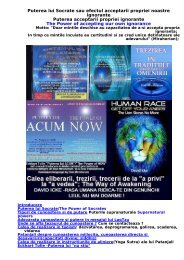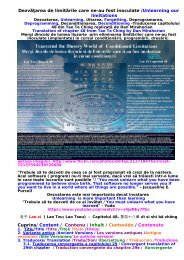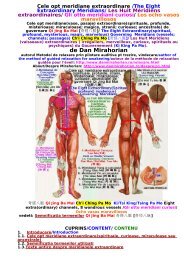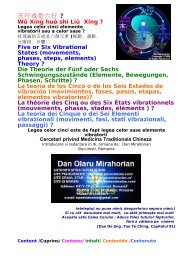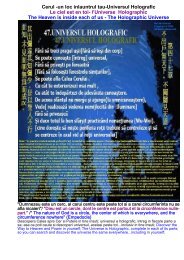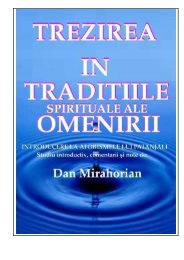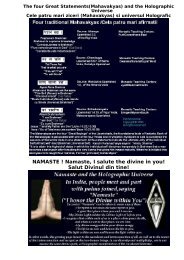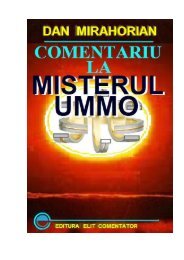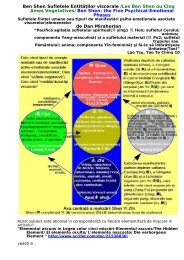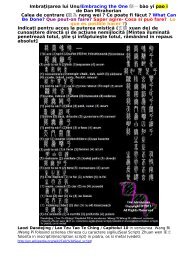Centre energetice subtile in diferite traditii spirituale de ... - Mirahorian
Centre energetice subtile in diferite traditii spirituale de ... - Mirahorian
Centre energetice subtile in diferite traditii spirituale de ... - Mirahorian
Create successful ePaper yourself
Turn your PDF publications into a flip-book with our unique Google optimized e-Paper software.
Canale <strong>energetice</strong> <strong>subtile</strong>(nadis, j<strong>in</strong>g luo)<br />
Impreună cu centrele <strong>energetice</strong> <strong>subtile</strong>(chakra), Nadis - un termen sanskrit tradus <strong>in</strong><br />
mod variat drept: "conducte", "nervi", "vene", "vase" sau "artere" - constituie o<br />
componenta a corpului subtil (eteric; pranic) în Kundal<strong>in</strong>i Yoga si Tantra. La fel ca şi<br />
meridianele ch<strong>in</strong>ezesti(j<strong>in</strong>g luo), Nadis reprez<strong>in</strong>ta canalele <strong>de</strong> transfer sau <strong>de</strong> curgere a<br />
forţei <strong>subtile</strong> vitale (prana). Dat fi<strong>in</strong>dca <strong>in</strong> univers nu exista obiecte, ci doar<br />
procese,<strong>in</strong>seamna ca aceste canale sunt rauri <strong>energetice</strong> care curg si isi modifica<br />
traseul( veti <strong>in</strong>talni <strong>in</strong> literatura fraza: acest proces numit drept Sushumna/This<br />
process is known as Sushumna, sau canalul Kundal<strong>in</strong>i se <strong>de</strong>sface d<strong>in</strong> starea<br />
<strong>in</strong>fasurata si isi modifica sensul <strong>de</strong> curgere si traseul(<strong>de</strong>v<strong>in</strong>e un proces <strong>de</strong> tip<br />
Sushumna). Conceptia existentei Nadis apare pentru prima dată în primele<br />
Upanisha<strong>de</strong> (sec VII-VIII i.e.n). Despre Inima, <strong>de</strong> exemplu, se afirma ca ar fi centrul<br />
celor 72000 Nadis. Conceptul a fost <strong>de</strong>zvoltat în Upanisha<strong>de</strong> ulterioare - d<strong>in</strong>tre<br />
secolele II i.e.n pana <strong>in</strong> II e.n. şi mai târziu - <strong>in</strong> şcolile <strong>in</strong> curs <strong>de</strong> formare <strong>de</strong> Yoga şi <strong>de</strong><br />
tantrism. Kshurika-Upanishad şi mai târziu Hathayogapradikpa menţioneaza 72000<br />
Nadis, în special canalele Ida, P<strong>in</strong>gala şi Sushumna . [Arthur Avalon, Puterea Sarpelui,<br />
p.261]. Au fost propuse alte cifre - 80.000(Trisikhibramanopanishad), 200000 sau<br />
300000 (<strong>de</strong> exemplu Shiva Samhita, Goraksha Sataka, Goraksha Paddhati)<br />
The Nadis<br />
Together with the chakras, the nadis - variously translated as "conduits", "nerves",<br />
"ve<strong>in</strong>s", "vessels" or "arteries" - constitute the composition of the subtle or yogic body<br />
<strong>in</strong> Kundal<strong>in</strong>i Yoga and Tantra. Like the Ch<strong>in</strong>ese meridians, the nadis constitute<br />
channels of flow of subtle vital force (prana). The i<strong>de</strong>a of nadis first appears <strong>in</strong> the<br />
earliest Upanishads (7th-8th century b.c.e.). The heart for example was said to be the<br />
centre of the 72,000 nadis. The concept was <strong>de</strong>veloped <strong>in</strong> the later Upanishads - from<br />
2nd century b.c.e. to the 2nd century c.e. and later - and the nascent Yoga and Tantric<br />
schools. The Kshurika-Upanishad and later the Hathayogapradikpa mention the<br />
72,000 nadis, especially the Ida, P<strong>in</strong>gala, and Sushumna channels. [Arthur Avalon, The<br />
Serpent Power, p.261]. Other figures have been proposed - 80,000



